| Review - Gates
Underwater Housing for the Sony FX1 & Z1U |
January, 2006

Gates
Underwater Housing for the Sony FX1 & Z1U
www.gateshousings.com
$4,440
Review by Steve
Douglas
Now
that you have invested your hard earned cash in order to buy
that High Definition Video Sony FX1 or Z1U you've been wanting,
trying to decide which underwater housing to slide it into is
a major concern to any underwater film maker. The Sony FX-1 and
Z1U are both expensive camcorders for most, and wanting the utmost
in protection for them is of prime consideration.
There are several factors to concern
yourself with; you certainly must be assured of your camcorders
protection from the elements, the housing's durability, and ease
of use. Your housing must also supply all the necessary controls
under the ocean that you would need and want when topside where
the camcorder would be in your hands or on your tripod.
Gates Underwater Products has produced
just the thing for the scuba diver and filmmaker who wish to
bring back the beauty of the depths on high definition video.
In business for over 36 years, the San Diego based Gates Products
have continually been in the forefront of providing underwater
housings for the underwater photographer and videographer almost
as quickly as the camcorders hit the market. Keeping up with
the many electronic innovations to hit our shores has not always
been easy but whether it was 8mm, Mini DV or HDV, Gates has been
there for those who insist that the underwater world must be
shared via photography and video.
The housing for the FX-1 and Z1U
provides almost everything one could ask for. To start off with,
made from machined aluminum, it is rated for depths of up to
450 feet/137 meters. Since 98% of most diver/videographers rarely
venture below 130 feet/40 meters and the remaining 2% rarely
drop below 200 feet/61meters, it is safe to say that this housing
can withstand a lot more than anyone will throw at it. The aluminum
itself is a 6061 T6 tempered material with a black type III hard
anodized finish and then sealed with a nickel acetate process.
Now I am not going to pretend that I understand all there is
to know about the processing of this housing but I will bare
witness that this housing really is bulletproof. I have seen
many a Gates housing in the past dropped, bounced, scraped over
underwater rocks and ledges and generally treated less respectfully
than their owners should have, and the housings continued to
do their job. This housing is no different.
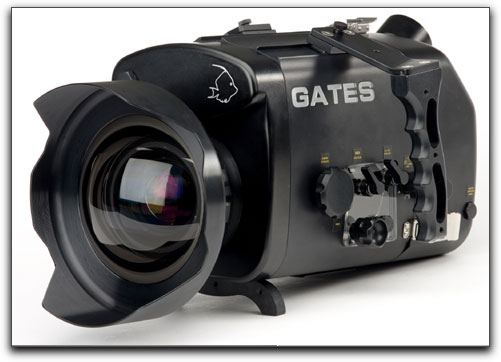
Gates
Housing for the Sony X1 & Z1U sans monitor or lights.
The Sony FX-1 and Z1U camcorders
are good-sized cams; the flip up LCD screen, now placed on top
next to the hot shoe takes up room and the Gates housing was
built to accommodate that. This is no pint-sized housing; it
is 16" long, 10" in height and with the handles on,
15" wide with a topside weight of 22lbs without the camcorder
or batteries. You do not need to start working out at the local
gym to transport this housing but I wouldn't plan on taking it
out for a long hike either. Gates does supply an optional top
handle to help you transport your system over land or simply
to lower into or take out of the water. The larger the housing
the more inherently stable it is in the water. This translates
to fluid, solid (non-shaky) shots. Obviously, the converse is
true: small housings are prone to a lot of shakiness. In our
MTV world this seems to be more acceptable, but any feature length
production or quality TV broadcast avoids a shaky camera. Once
in the water, the housing, with camcorder in place, is only slightly
negatively buoyant. Buoyancy can be fine-tuned, positive or negative
to your preferences. This is an important asset. Just as when
shooting topside, a camcorder with a bit of heft, adds steadiness
to a hand held shot, I have found that a housing with a slight
negative balance also aids in holding a static shot or smooth
pan. I have used other housings, which were positively buoyant
in the water and found them to be more susceptible to current
or surge. However, keep in mind that susceptibility to surge
or current is a function of the size, not necessarily it's buoyancy.
The bigger it is, the more it acts like a sail. Unplanned shakiness
in any shot will usually demand a retake and, underwater, most
fish do not hang around for take 2, 3 or 4. Then again, the sharks
might come back for another taste; ooops, I mean 'take' but that
is another matter. Thus, the solid feel and balance of the Gates
housing for the FX-1/Z1U provides confidence to the demanding
underwater videographer.
In addition, there is a Pole-cam
attachment made for those who want to put their systems in the
water but not go in themselves. These pole cams, manufactured
by underwater videographer, Bob Gladden, and distributed by Gates
Underwater Products, are extremely useful when filming Great
Whites when a cage is not handy or when doing underwater searches.
The pole cam attachment to the Gates housing provides a great
deal of control and matches to the housing with the safety and
security of your housing and cam in mind.
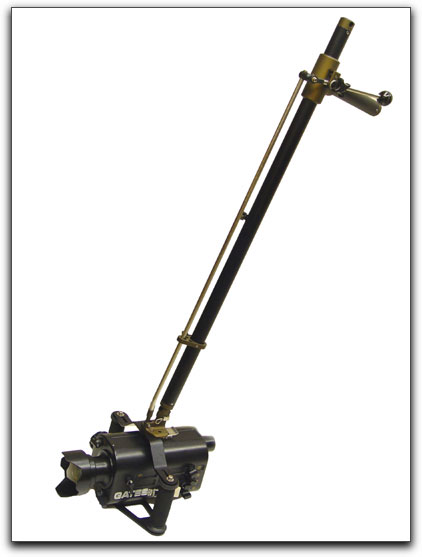
Pole
cam controls all movements of the housing while you stay topside
nice and dry.
Typical of all Gates housings,
the controls are mechanical and plentiful. I have always preferred
a mechanical control as it is assuring to me when off on some
exotic vacation or shoot somewhere that, because they are mechanical,
nothing will go wrong with them. You press or turn a mechanical
control and it works; there are no batteries that have been drained,
no electronic boards to fry or contacts that fail when you need
them most. The color coded controls that you will find most necessary
underwater are all accessible with this housing, the power on/off,
record/standby, zoom, switching from auto to manual focus, white
balance mode/set, Iris, and neutral density filter. Optional
controls for gain and white balance presets, expanded focus and
shutter speed are also available.
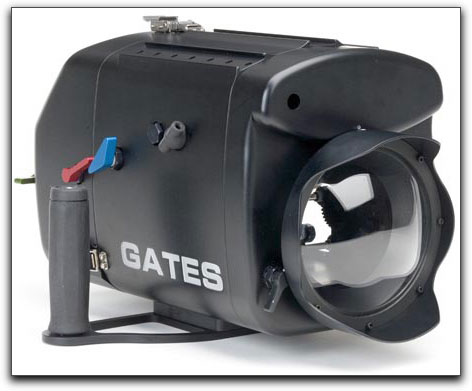
Just
some of the many color coded control levers.
The camcorder installs neatly and
simply by attaching it to a bottom 'tray' which then slides into
place in the housing secured quickly by thumbscrews. Also in
the housing is a color correction internal flip filter available
in blue or green water versions. I find that most dive/filming
conditions require the blue water version and the flip filter
is easy to flip on or off. A second flip filter can be optionally
installed for either a diopter for macro work or a second UR
filter either blue or green.
A connection can be found inside
the housing, which plugs into your video out on the camcorder.
This supplies your picture should you choose to add an external
color monitor to the housing. While the monitor is an optional
purchase, it is one that is not superfluous. I find them to be
very helpful when setting up a shot's composition or when I am
swimming straight into a large school of jacks, barracuda or
even hammer head sharks. The monitor fits neatly into the accessory
dovetail rails, which then can be slid forward or backward to
whatever location on the housing is most comfortable to you.
However, acknowledging that the
HDV critical focus is extremely important due to the inherent
6X resolution over standard DV, for close up macro work and critical
focus situations I bring my eye back down to the higher resolution
of the magnified viewfinder on the housing's rear plate. As an
extra note on this topic, the video out provided by the housing
can also be used to run a feed to a surface monitor as well.
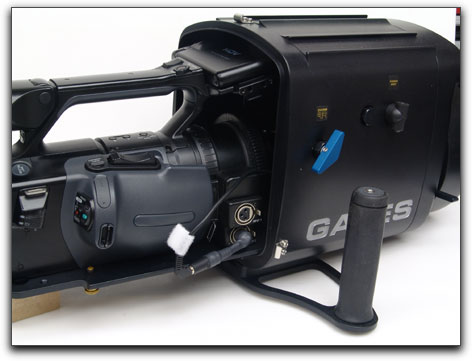
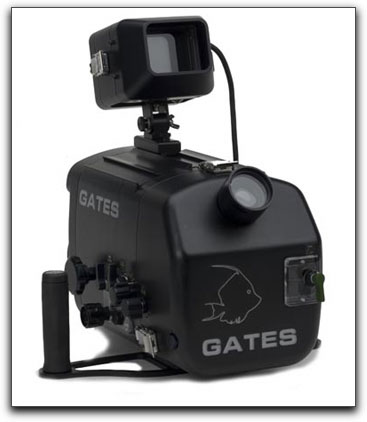
Connection
from Sony Z1U's video out feeds to monitor on top of housing.
There are other manufacturers of quality
underwater housings. However, several of them do not allow room
for the larger camcorder batteries. This limits the shooter to
more frequent battery changes and, therefore, more times that
the housing itself must be opened in order to get to the camcorder.
When any housing is open, there is an increased vulnerability
for the camcorder. Someone shaking a wet head of hair, spilling
a drink on the camera table, or simply greater exposure to the
salt air is not good for your Sony. The Gates housing for the
FX-1/Z1-U will allow batteries up to the NPF 970 providing more
'in housing time'. Access to the camcorder is excellent, as you
do not need to remove the cam from the Gates housing to switch
out either tape or battery. You simply unlatch the back plate,
install your next battery or tape and close it up again. This
fast and easy process limits unfortunate occurrences including
floods. Operator error is the most common reason why a housing
may get water inside, usually a disastrous event so the less
a housing has to be opened, the less risk of problems.
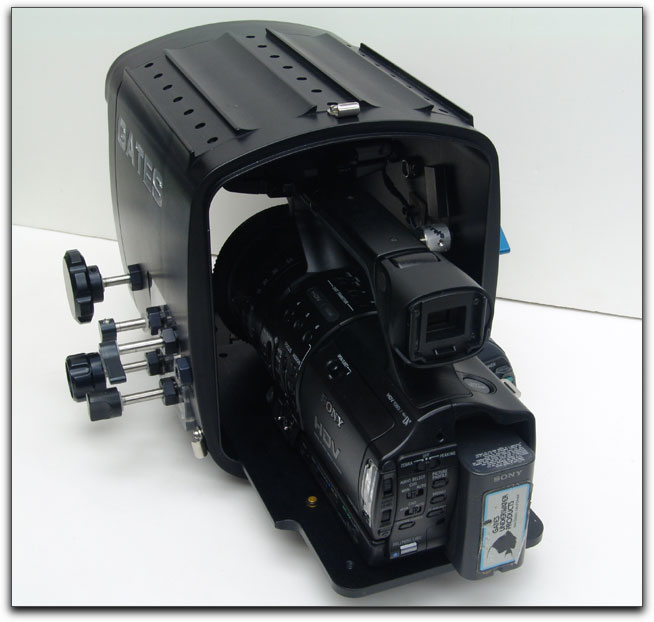
The
sliding tray, tightened with thumbscrews, holds the camcorder
securely in place.
Meanwhile, there is easy access to the camcorder
itself.
Once the FX1 or Z1U is installed
the rear of the housing closes securely with three separate Positive
Lock stainless steel latches, which confirm for you that your
housing is correctly sealed and ready to go. This is a 'tried
and true' method of establishing an o-ring seal on a pressure-proof
housing. Each latch places over 50 lbs of positive force on the
o-ring surface, assuring a seal both in shallow water (where
rinse tank floods occur) and deep water as well. While I always,
as a habit, check these latches before going underwater, I have
never had one fail on me or accidentally open up.
The dome port that comes standard
with this housing is made from optical acrylic material that
is field replaceable. Other Gates ports have polycarbonate domes
which have an anti-scratch coating and are also field replaceable
should the need arise. I have used this same dome type on several
different Gates housings and have found them to be of very good
quality. Minor scratches gotten from an unintended ledge generally
do not effect the shot, however, should a more severe scratch
be incurred, that you can change out the port for a new one is
a valuable asset particularly in remote regions of the globe
where your shoot may be held. A standard, or dome port, corrects
for the distortions of water (the 25% closer/larger similar to
that which you experience with your facemask). The dome port
does not magnify a camera's FOV but rather preserves what is
already in the camera.
Gates does supply optional Super
Wide Angle and Super Macro Ports of exceptional quality made
by Fathom Imaging. These are not cheap but to the videographer
who must have the very best; these will do the job beautifully.
Any port is interchangeable via a bayonet mount for easy switching.
The standard port will allow you to zoom through about two-thirds
of the focal length without needing to adjust your focus.
All Gates Underwater video housings
come with a two-year renewable warranty and the housing for the
Sony FX-1/Z1-U is no exception. All maintenance and repairs are
done 'in house' so you needn't worry about your housing getting
misplaced in Korea somewhere.
The bottom line is that if you
are a videographer whose desire is to have the utmost in protection
and reliability in an underwater housing for your Sony HDV cam,
than this housing just can't be overlooked. Its absolute ruggedness
and dependability is virtually assured. This is one product I
can enthusiastically say for the very first time, "Tell
'em Steve sent you". You'll be happy you did.
Steve Douglas, is an underwater videographer and contributor
to numerous film festivals around the world. A winner of the
1999 Pacific Coast Underwater Film Competition, 2003 IVIE competition,
2004 Los Angeles Underwater Photographic competition, and the
prestigious 2005 International Beneath the Sea Film Competition,
Steve has also worked on the feature film "The Deep Blue
Sea", contributed footage to the Seaworld parks for their
Atlantis production, and is one of the principal organizers of
the San Diego UnderSea Film Exhibition. Steve leads both underwater
filming expeditions and African safaris with upcoming filming
excursions to Kenya, Bali and the Red Sea. Feel free to contact
him if you are interested in joining Steve on any of these trips.
www.worldfilmsandtravel.com
copyright © Steve
Douglas 2006
This article first appeared on www.kenstone.net and is reprinted here
with permission.
All screen captures and
textual references are the property and trademark of their creators/owners/publishers.